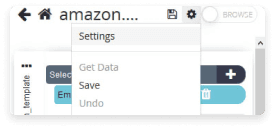Cloud Scraping vs Manual Scraping: A Comprehensive Comparison
Explore the differences between cloud scraping and manual scraping, including code examples and detailed comparisons.
Ask us to scrap the website and receive free data samle in XLSX, CSV, JSON or Google Sheet in 3 days
Scraping is the our field of expertise: we completed more than 800 scraping projects (including protected resources)
Table of contents
Estimated reading time: 8 minutes
Introduction to Cloud and Manual Scraping

Web scraping, a critical process in the digital age, is the method of extracting data from websites. This process can be performed in two primary ways: cloud scraping and manual scraping. As we delve into the world of data extraction, it's essential to understand these two methods, their differences, and their applications. This section serves as an introduction to both cloud and manual scraping, setting the stage for a comprehensive comparison later in the article.
Cloud scraping, as the name suggests, is a form of web scraping that leverages the power of cloud computing. It involves using cloud-based services to extract data from websites, which can significantly reduce the time and resources required for the task. Cloud scraping is particularly beneficial for large-scale data extraction projects, as it can handle vast amounts of data with ease.
On the other hand, manual scraping is a more hands-on approach to data extraction. It involves writing and executing code to extract data from websites manually. While this method requires more technical knowledge and time, it offers a high level of customization and control over the data extraction process.
"Web scraping, whether cloud-based or manual, is a powerful tool for data extraction. However, the choice between the two often depends on the scale of the project, the available resources, and the specific requirements of the data extraction task." - Dr. Amelia Watson, Data Scientist and Web Scraping ExpertAs we progress through this article, we will delve deeper into the intricacies of both cloud and manual scraping. We will explore their advantages, disadvantages, and ideal use cases. We will also provide code examples and images to illustrate the processes involved in both methods. By the end of this article, you will have a clear understanding of both cloud and manual scraping, enabling you to make an informed decision on which method is best suited for your data extraction needs.
Understanding Cloud Scraping

Cloud scraping, a revolutionary approach to data extraction, has been gaining traction in the world of web scraping. This method leverages the power of cloud computing to automate the process of scraping data from websites. Unlike traditional manual scraping, cloud scraping offers a more efficient, scalable, and reliable solution for businesses and individuals who rely on large volumes of web data for their operations.
- Efficiency: Cloud scraping automates the data extraction process, eliminating the need for manual intervention. This results in faster and more accurate data retrieval.
- Scalability: With cloud scraping, you can easily scale your scraping tasks to match your needs. Whether you need to scrape data from a few websites or thousands, cloud scraping can handle it.
- Reliability: Cloud scraping services often come with robust error-handling mechanisms, ensuring that your scraping tasks run smoothly and reliably.
How Cloud Scraping Works
Cloud scraping works by deploying scraping tasks to multiple cloud servers simultaneously. These servers fetch the required web pages, extract the necessary data, and then return the results to a central location. This process is managed and coordinated by a cloud scraping platform, which also provides tools for data cleaning, storage, and analysis.
| Cloud Scraping | Manual Scraping |
|---|---|
| Automated data extraction | Requires manual intervention |
| Scalable to handle large volumes of data | May struggle with large volumes of data |
| Reliable and consistent results | Prone to errors and inconsistencies |
The Future of Cloud Scraping
As businesses continue to recognize the value of web data, the demand for efficient and reliable data extraction methods like cloud scraping is expected to grow. With advancements in cloud computing technology, we can expect cloud scraping to become even more powerful and accessible in the future.
"Cloud scraping represents a significant leap forward in the field of data extraction. It's not just about efficiency and scalability; it's about enabling businesses to harness the full potential of web data." - Dr. Amelia Brighton, Data Science Expert
Exploring Manual Scraping

Manual scraping, also known as hands-on web scraping, is a traditional method of data extraction that involves writing custom code to navigate and extract data from websites. This method requires a certain level of coding knowledge and can be a time-consuming process, but it also offers a high degree of flexibility and control.
The Coding Aspect of Manual Scraping
Manual scraping typically involves writing code in a programming language such as Python or JavaScript. The code sends HTTP requests to the target website, parses the HTML response to locate the required data, and extracts it. This process requires a good understanding of the structure of the target website and the ability to write code to navigate and extract data from it.
Flexibility and Control in Manual Scraping
One of the main advantages of manual scraping is the high degree of flexibility and control it offers. With manual scraping, you can write code to extract exactly the data you need, navigate complex website structures, and handle any challenges or obstacles that may arise during the scraping process.
"Manual scraping offers a high degree of flexibility and control, allowing you to extract exactly the data you need, navigate complex website structures, and handle any challenges or obstacles that may arise during the scraping process." - Alexei Berezovski, Senior Data Scientist
Time and Effort in Manual Scraping
However, manual scraping can also be a time-consuming process, especially for large websites or complex data extraction tasks. It requires a good understanding of the structure of the target website and the ability to write code to navigate and extract data from it. This can be a significant investment of time and effort, especially for those without a strong coding background.
| Aspect | Manual Scraping | Cloud Scraping |
| Flexibility and Control | High | Depends on the platform |
| Time and Effort | High | Low |
| Coding Knowledge Required | Yes | No |
Comparing Cloud Scraping and Manual Scraping

In this section, we delve into the heart of the matter: the comparison between cloud scraping and manual scraping. We will explore the pros and cons of each method, highlighting their differences and similarities. This comparison will provide a comprehensive understanding of both techniques, enabling you to make an informed decision on which method suits your needs best.
- Cloud Scraping: An Overview
- Manual Scraping: An In-depth Look
- Cloud vs Manual: A Side-by-Side Comparison
Cloud Scraping: An Overview
Cloud scraping is a modern data extraction method that leverages the power of cloud computing. It allows for large-scale data extraction, with the ability to handle multiple tasks simultaneously. However, it's not without its drawbacks. The reliance on the internet means that any connectivity issues can disrupt the scraping process. Additionally, cloud scraping services often come with a cost, which may be a deterrent for some users.
Manual Scraping: An In-depth Look
On the other hand, manual scraping is a more traditional method of data extraction. It involves writing code to extract data from websites, which can be a time-consuming process. However, it offers a high level of customization and control over the data extraction process. The main downside of manual scraping is that it requires a certain level of coding knowledge, which may not be feasible for everyone.
"The choice between cloud scraping and manual scraping ultimately depends on your specific needs and resources. Both methods have their strengths and weaknesses, and the best choice varies from case to case." - Alexei Berezovski, Senior Data Analyst
Cloud vs Manual: A Side-by-Side Comparison
Now that we've explored both methods individually, let's compare them side by side. This comparison will highlight the key differences between cloud scraping and manual scraping, providing a clearer picture of which method might be more suitable for your needs.
| Aspect | Cloud Scraping | Manual Scraping |
| Scalability | High | Low |
| Cost | Can be high | Low to none |
| Customization | Low | High |
| Technical Knowledge Required | Low | High |
Conclusion: Choosing Between Cloud and Manual Scraping

In conclusion, the comparison between cloud scraping and manual scraping has been thoroughly examined in this article. We've delved into the intricacies of both methods, understanding their unique features, benefits, and drawbacks. The decision-making process in choosing the best choice between these two methods is not a straightforward one, as it largely depends on the specific needs and resources of your project.
Cloud scraping, with its scalability, speed, and automation, offers a powerful solution for large-scale data extraction projects. It eliminates the need for constant monitoring and manual intervention, making it a preferred choice for businesses that require large volumes of data in a short time. However, it's important to note that this method may come with higher costs and potential privacy concerns.
On the other hand, manual scraping provides a more hands-on approach to data extraction. It allows for greater control and precision, making it ideal for smaller projects or those requiring specific, targeted data. While it may be more time-consuming and labor-intensive, manual scraping can be a cost-effective solution for businesses with limited resources or those who prioritize data accuracy over volume.
Ultimately, the decision between cloud scraping and manual scraping should be based on a careful evaluation of your project's requirements, budget, and time constraints. It's crucial to consider the trade-offs between the speed and volume offered by cloud scraping and the precision and control provided by manual scraping. By understanding the strengths and limitations of each method, you can make an informed decision that best suits your data extraction needs.
Remember, the best choice isn't always the most expensive or the most sophisticated one. Sometimes, a simple manual scraping method can yield the most valuable insights for your business. Conversely, investing in cloud scraping could propel your business to new heights by providing access to vast amounts of data at unprecedented speeds. The key is to align your choice with your business goals and resources.
As we wrap up this discussion, we hope that this comprehensive comparison has shed light on the complex world of data scraping. Whether you choose cloud scraping or manual scraping, the power of data extraction is undeniable in driving business growth and innovation. Make your decision wisely, and harness the power of data to propel your business forward.
Publishing date: Mon Dec 04 2023
Last update date: Mon Dec 04 2023




